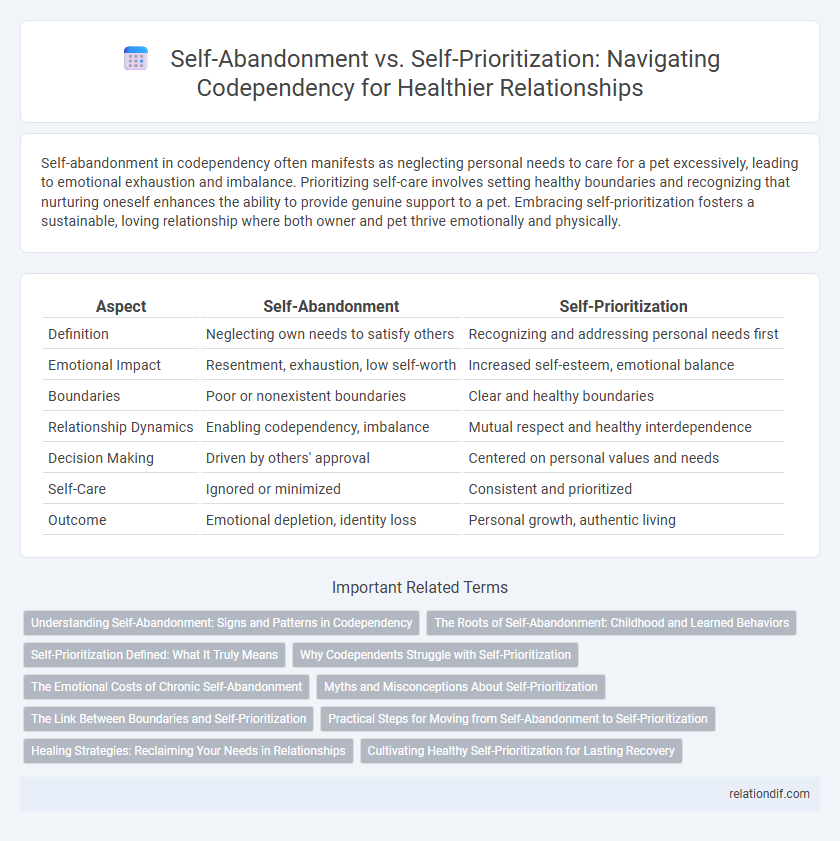Self-abandonment in codependency often manifests as neglecting personal needs to care for a pet excessively, leading to emotional exhaustion and imbalance. Prioritizing self-care involves setting healthy boundaries and recognizing that nurturing oneself enhances the ability to provide genuine support to a pet. Embracing self-prioritization fosters a sustainable, loving relationship where both owner and pet thrive emotionally and physically.
Table of Comparison
| Aspect | Self-Abandonment | Self-Prioritization |
|---|---|---|
| Definition | Neglecting own needs to satisfy others | Recognizing and addressing personal needs first |
| Emotional Impact | Resentment, exhaustion, low self-worth | Increased self-esteem, emotional balance |
| Boundaries | Poor or nonexistent boundaries | Clear and healthy boundaries |
| Relationship Dynamics | Enabling codependency, imbalance | Mutual respect and healthy interdependence |
| Decision Making | Driven by others' approval | Centered on personal values and needs |
| Self-Care | Ignored or minimized | Consistent and prioritized |
| Outcome | Emotional depletion, identity loss | Personal growth, authentic living |
Understanding Self-Abandonment: Signs and Patterns in Codependency
Self-abandonment in codependency manifests through patterns such as consistently neglecting personal needs, suppressing emotions, and prioritizing others' approval over self-worth. Key signs include chronic people-pleasing, guilt when setting boundaries, and loss of identity due to overinvolvement in others' lives. Recognizing these behaviors helps differentiate self-abandonment from healthy self-prioritization, essential for breaking the cycle of codependent relationships.
The Roots of Self-Abandonment: Childhood and Learned Behaviors
Self-abandonment often originates in childhood through learned behaviors where emotional needs were consistently unmet or dismissed, leading to a diminished sense of self-worth and identity. These early experiences condition individuals to prioritize others' needs over their own, establishing patterns of codependency. Healing self-prioritization requires recognizing these root causes and consciously reversing ingrained habits to foster autonomy and healthy boundaries.
Self-Prioritization Defined: What It Truly Means
Self-prioritization means recognizing and honoring your own needs, values, and boundaries without guilt or hesitation, enabling healthier relationships and emotional well-being. It involves setting clear limits, practicing self-care, and affirming personal worth, which contrasts sharply with self-abandonment where one's needs are consistently ignored or sacrificed. Embracing self-prioritization fosters resilience and balanced interactions, helping break cycles of codependency and promoting authentic self-respect.
Why Codependents Struggle with Self-Prioritization
Codependents struggle with self-prioritization due to deep-rooted patterns of self-abandonment, where their value is tied to others' approval and needs. This behavior stems from low self-worth and fear of rejection, causing them to neglect their own boundaries and well-being. Relearning self-prioritization involves building self-esteem and establishing healthy boundaries to break the cycle of codependency.
The Emotional Costs of Chronic Self-Abandonment
Chronic self-abandonment in codependency often leads to deep emotional exhaustion, diminished self-worth, and heightened anxiety. Persistent neglect of personal needs triggers feelings of resentment, emotional disconnection, and increased vulnerability to depression. Prioritizing self-care and boundaries is essential to restore emotional balance and foster healthier relationships.
Myths and Misconceptions About Self-Prioritization
Self-prioritization is often misunderstood as selfishness, which fuels myths that setting boundaries harms relationships or indicates weakness. These misconceptions overlook that healthy self-prioritization fosters resilience and authentic connections by preventing self-abandonment. Embracing self-care as a necessary practice rather than a luxury transforms how individuals in codependent dynamics maintain their well-being.
The Link Between Boundaries and Self-Prioritization
Setting and maintaining healthy boundaries is crucial for effective self-prioritization, as it prevents self-abandonment by ensuring personal needs and limits are respected. Codependency often involves porous boundaries where individuals sacrifice their well-being to appease others, undermining self-care and autonomy. Strengthening boundaries empowers individuals to reclaim their identity, promoting emotional resilience and balanced relationships.
Practical Steps for Moving from Self-Abandonment to Self-Prioritization
Establishing clear boundaries is essential for transitioning from self-abandonment to self-prioritization, enabling individuals to protect their emotional and physical well-being. Practicing mindfulness and self-reflection helps identify personal needs and values, fostering healthier decision-making and self-care routines. Consistent commitment to saying no when necessary and seeking supportive relationships strengthens resilience against reverting to codependent patterns.
Healing Strategies: Reclaiming Your Needs in Relationships
Healing from self-abandonment requires identifying and asserting your personal needs without guilt, fostering self-prioritization through consistent boundary-setting. Practicing mindfulness and journaling helps in recognizing patterns of codependency, allowing for intentional shifts toward self-care and emotional autonomy. Engaging in therapy or support groups provides guidance for rebuilding self-worth and reclaiming a balanced sense of identity within relationships.
Cultivating Healthy Self-Prioritization for Lasting Recovery
Cultivating healthy self-prioritization is essential for lasting recovery from codependency by setting clear boundaries and honoring personal needs without guilt. Emphasizing self-care practices, emotional self-awareness, and assertive communication enables individuals to reclaim their autonomy and foster balanced relationships. Consistent commitment to these strategies strengthens resilience, supports emotional well-being, and prevents relapse into patterns of self-abandonment.
Self-abandonment vs Self-prioritization Infographic

 relationdif.com
relationdif.com